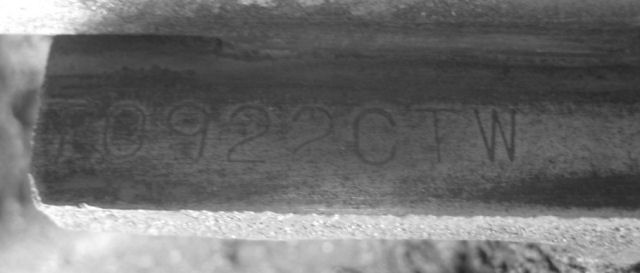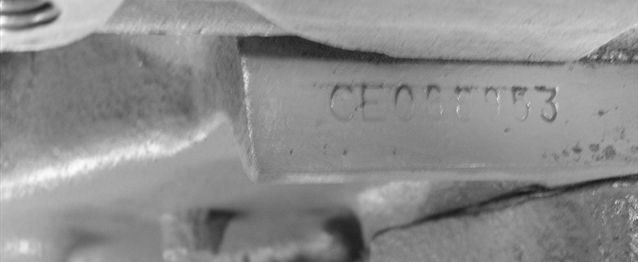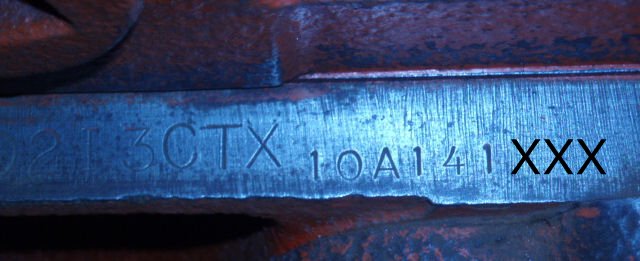Date Stamp Characters
| V8 Engine Block Casting Month Codes | |||
| A - January | B - February | C - March | D - April |
| E - May | F - June | G - July | H - August |
| I - September | J - October | K - November | L - December |
Date codes consists of a letter, 1 or 2 digits for the day, and 1 digit for the year such as J 25 7 would be October 25, 1967.
The block casting number on small block and big block Chevy V8 motors is located on a ledge found at the rear of the block, most often on the driver's side. This ledge is below the deck of the block and the ledge forms the mating surface between the block and the transmission bellhousing.
Engine Assembly
Date/Suffix Code:
The engine assembly code looks similar to this: T0601ED.
In this case the first letter "T" stands
for an engine factory Tonawanda Engine Plant, either "F"
or "V" would indicate Flint, MI., "K"
is used for McKinnon Industries while "S"
is used for Saginaw Service. The next two digits stand for the month
of the year. In this example "06" or the
sixth month, June. The "01" stands for the
1st day of the month. Sometimes (but not always) the letter "I"
is substituted for the number "1".
So what do we have so far in this example? The motor was assembled at the Tonawanda factory on June 1st. The year is not specifically stamped. What we have left is the "suffix code" which in this example is ED, a 1966 396cid/325hp for a manual transmission. Chevy used one to three letters of the alphabet to code the type of engine, transmission and vehicle into the suffix code. In that case you might see "T0601ED 6A174373" stamped into the pad on the front passenger side of the block. In this example, 6A174373 decodes to 1966 Atlanta final assembly, and the last six digits of the VIN. Depending on the year and plant, the partial VIN could be stamped into a different area of the block; the flange edge of the rear of the block near the bellhousing mating surface, the rough cast area next to the oil filter and sometimes the stamping is found above the timing cover mating surface on the front of the block.
Beginning January 1, 1968 the federal government requested voluntary compliance of identifying major parts of a motor vehicle by inscribing or affixing an identifying number or symbol on major parts. As far as research has shown, Chevrolet did comply. by stamping a partial VIN on all engine blocks(1). Again, the location on the block may vary between the plants and years but one change was made in 1968. The GM division number ('1' for Chevrolet) was added to the partial VIN. A 1968 version of an Atlanta partial VIN stamping would 18A174373.

vs.


Beginning in late 1969 model year, 3-letter engine suffix codes were used on the engine pad. This example happens to be a September 22-built 1970 396 engine with a TH400 transmission as noted by the CTW suffix code.
The plant, date, and engine ID codes were stamped at the respective engine assembly plants while the partial VINs (when applicable) were stamped at the final assembly plant. Therefore the two stampings will have different fonts, character sizes, and in some cases will be stamped at different locations on the engine block.
There is another type of stamping found on some blocks. This is the "CE" code. You might see something like this "CE056789" on the front pad of the block deck on the passenger side. The "CE" stands for "Chevrolet Engine" but is often erroneously referred to as "Counter Engine", "Counter Exchange" and "Crate Engine" was used on blocks that were warranty replacement engines. If a customer had problems with his original engine, while it was under warranty, it was replaced with an engine that was stamped "CE" with a 6-digit number following it which serialized that particular engine. It's important to note that the "CE" designation for replacement Chevrolet engines did not start until 1968 so any year designation in the engine number would be for 1968 and later. The CE block stamp year is the year the block was stamped and not for what year of car the block was destined for since a generic block for fitted engine could be used as a warranty replacement for any number of years' engines, applications, and for cars produced from any assembly plant.

Here you can clearly see the CE067997 stamping on the engine pad. This
one produced in 1970 at Tonawanda with engine serial number 67997.

Here you can clearly see the CE173170 stamping on the engine pad. This
one produced in 1971 at Tonawanda with engine serial number 73170.

Another CE stamping, this one is 066953 from 1970.

A calendar year 1973 replacement engine #356957

A calendar year 1973 replacement engine #367742

Warranty engines will be date stamped on the starter mount pad.
Here T099 represents Tonawanda (T), September (09), 1969 (9)

Warranty engines will be date stamped on the starter mount pad.
Here T099 represents Tonawanda (T), June (06), 1973 (3)

It's been reported that beginning in 1970, if more engines were needed at a given plant in a year than the range of sequence numbers allotted, the plant would re-use the numbers using the letter "A" after the "CE" and year designation. For example, Tonawanda was assigned the sequence range of 50,000 to 79,999 so if more engines were required the numbering would start over again at 50,000 but the "CE" prefix would become "CExA" where 'x' is the year such as CE0A50000.
It is believed this method of identifying replacement engines stopped after the 1975 model year. This is supported by a notation in a 1976 dated Chevrolet parts book, "The engine plants are to stamp the serial pad of all current model service engines with the source, production date, and same type designation as stamped on a comparable production engine."
V8 Engine Block Casting Numbers By Year (1964-1972)
Partial VIN stamping on engine blocks.


Often referred to as a gang stamp because the partial VIN characters (or in this case a Flint engine plant stamp) was used to 'gang' the characters into one even line for stamping as opposed to each character being individually stamped.
Before a federal mandate that all engine blocks be stamped with a partial VIN, generally, only the 396 engines from 1965, 1966 & 1967 Chevelles along with the L79 engine blocks from 1965 & 1967 Chevelles were stamped with a partial VIN. These were done by hand and by individual character often resulting in some very strange looking engine pads. The partial VIN consisted of a single number representing the model year, a letter for the final assembly plant, and followed by the six-digit sequence number of the vehicle.
Beginning January 1, 1968, by federal mandate, all engine blocks would be stamped with a partial VIN consisting of a single number for the General Motors division (Chevrolet's number is "1"), followed by the same information as before; the model year, plant, and sequence number. General Motors standardized this procedure by using what's called a "gang stamp" as shown in the photo above. Each individual stamped character was placed in a holder and secured before the engine block was struck by the employee responsible for doing this task. This holder allowed for consistency in the particular characters used and assured the partial VIN stamp was uniformly done from car to car. Even though some plants elected to stamp partial VINs on other locations beside the engine pad (such as the rough cast area by the oil filter boss or on the bellhousing flange), most plants for most years did stamp the partial VIN on the engine pad next to the Flint or Tonawanda engine assembly date and ID letters.

1970 Van Nuys example of the partial VIN stamped on the rough cast area
by the oil filter.

1970 Atlanta example of the partial VIN stamped on the engine pad.
Not to say mistakes weren't made as the person responsible had to insure the numbers were changed for each vehicle as necessary. The plants employed a 'blank' stamp to obliterate a mistaken stamp so the corrected stamp could be applied.
(1) There is a question as to whether this date is accurate for federal mandate that engine blocks be stamped with a partial VIN. The information has been found on numerous Ford sites such as http://428cobrajet.org/id-block.html stating, "Starting in 1967 for the 1968 model year, Ford began stamping partial VIN information on production engine blocks to meet the requirements of Title 49, United States Code, Subtitle VI, Part C, Chapter 331 (effective January 1, 1968)." Reading section 33107 "Voluntary vehicle identification number" sounds more like this was not mandated but was voluntary to comply as long as they did comply with sections 33102 and 33103. See http://uscode.house.gov/download/pls/49C331.txt or search the Internet for "Title 49, United States Code, Subtitle VI, Part C, Chapter 331" for more websites with information.
MoPar forums searched seem to indicate that MoPar didn't follow the compliance until sometime midyear, 1968.
Transmission
Transmissions were also subject to replacement, be it just the case or the entire transmission. These will have a stamp something like "CC" for Chevrolet Case or "CT" for Chevrolet Transmission. The same information about partial VINs on engine blocks also applies to transmissions.
 Home
Home Decode
Decode Tech
Tech Tools
Tools My Books
My Books Contact
Contact Chevelle
of the Month
Chevelle
of the Month Things
For Sale
Things
For Sale